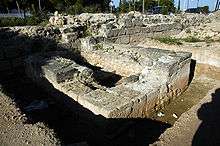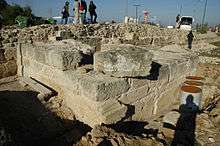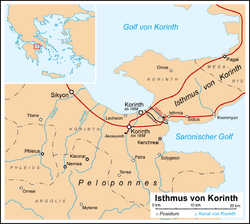Hexamilion wall
The Hexamilion wall (Greek: Εξαμίλιον τείχος, "six-mile wall") was a defensive wall constructed across the Isthmus of Corinth, guarding the only land route onto the Peloponnese peninsula from mainland Greece.
Εξαμίλιον τείχος (in Greek) | |
 A preserved portion of the wall with the base of a tower. | |
 Shown within Greece | |
| Location | Corinth, Corinthia, Greece |
|---|---|
| Region | Corinthia |
| Coordinates | 37°55′34″N 22°58′21″E |
| Type | Defensive wall |
| History | |
| Periods | Early Medieval to Late Medieval |
| Site notes | |
| Condition | Ruined |
| Ownership | Public |
| Management | 25th Ephorate of Byzantine Antiquities |
| Public access | Yes |
| Website | Hellenic Ministry for Culture and Tourism |
History
Early fortifications
The Hexamilion stands at the end of a long series of attempts to fortify the isthmus stretching back to perhaps the Mycenean period.[1] Many of the Peloponnesian cities wanted to pull back and fortify the isthmus instead of making a stand at Thermopylae when Xerxes invaded in 480 BC (Herodotus' Histories 7.206). The issue arose again before the Battle of Salamis (Herodotos 8.40, 49, 56). Although the concept of a "Fortress Peloponnese" had been repeatedly suggested, fortification of the isthmus was of no utility without control of the sea, as Herodotus notes (7.138).
The Hexamilion and its history
The wall was constructed in the period between 408 AD and 450 AD, in the reign of Theodosius II during the time of the great Barbarian invasions into the Roman Empire. The attack of Alaric on Greece in 396 AD or the sack of Rome in 410 AD by the Visigoths may have motivated the construction, which included towers, sea bastions, and at minimum one fortress.[2] The one known fortress contained two gates (north and south), of which the northern gate functioned as the formal entrance to the Peloponnese.[3] The wall was constructed with a rubble and mortar core faced with squared stones. It is not certain how long it took to complete, but the importance given to the task is apparent from the scale of the construction; the Hexamilion is the largest archaeological structure in Greece. Every structure in the region was cannibalized for stone for the effort, either being incorporated into the wall directly, as was the temple of Poseidon at Isthmia, or being burned into lime, as was the sanctuary of Hera at Perachora as well as much of the ancient statuary of Corinth. In the reign of Justinian, the wall was fortified with additional towers, reaching a total number of 153. Military use appears to have fallen off after the 7th century AD, and by the 11th AD domestic structures were being built into the wall.
In 1415, the Byzantine emperor Manuel II personally supervised repairs over a period of forty days. The high cost of this effort caused unrest among the local elite. The wall was breached in 1423 and again in 1431 by the Ottomans under the command of Turahan Bey.[4] Constantine Palaiologos, who was Despot of Morea before his accession to the throne of the Byzantine empire, restored the wall again in 1444, but the Ottomans breached it again in 1446 and in October 1452.[4] After the fall of Constantinople in 1453 and the Ottoman conquest of the Peloponnese in 1460, the wall was abandoned. During its history, the wall never succeeded in fulfilling the function for which it was constructed, unless it acted as a deterrent. Elements of the wall are preserved south of the Corinth Canal and at the Sanctuary of Poseidon at Isthmia.
Images of the Hexamilion
 Detail of a tower foundation showing a spoliated architectural member with carved molding.
Detail of a tower foundation showing a spoliated architectural member with carved molding. Section of the wall facing northwest.
Section of the wall facing northwest. View along the line of the wall showing rubble core.
View along the line of the wall showing rubble core. Detail of the construction showing rubble core and worked stone facing.
Detail of the construction showing rubble core and worked stone facing. map of the Isthmus of Corinth showing the Hexamilion location.
map of the Isthmus of Corinth showing the Hexamilion location.
Notes
- See Broneer and Wiseman for arguments for pre-Roman fortification walls across the isthmus.
- Gregory uses numismatic evidence to date the construction to 400 to 420 AD.
- Gregory describes the development of this northern gateway from its origin as a 1st-century CE Roman arch.
- Setton, Kenneth M. (1978), The Papacy and the Levant (1204–1571), Volume II: The Fifteenth Century, DIANE Publishing, pp. 38, 96, 97, 146, ISBN 0-87169-127-2
References
Secondary sources on the Hexamilion
- Barker, J. W. (New Brunswick, NJ 1969). Manuel II Paleologus (1391–1425): A Study in Late Byzantine Statesmanship.
- Clement, P. A. (Thessaloniki 1977) “The Date of the Hexamilion” in Essays in Memory of Basil Laourdas.
- Fowden, G. (JRA 8 (1995), p. 549-567). “Late Roman Achaea: Identity and Defense.”
- Gregory, T. E. (Princeton, NJ 1993). The Hexamilion and the Fortress. (Isthmia vol. 5).
- Hohlfelder, R. (GRBS 18 (1977), p. 173-179). "Trans-Isthmian Walls in the Age of Justinian."
- Jenkins, R. J. H. and H. Megaw. (BSA 32 (1931/1932) p. 68-89). “Researches at Isthmia.”
- Johnson, S. (London 1983). Late Roman Fortifications.
- Lawrence, A. W. (BSA 78 (1983), p. 171-233). “A Skeletal History of Byzantine Fortification.”
- Leake, W. M. (London 1830). Travels in the Morea.
- Monceaux, P. (Gazette archéologique (1884), p. 273-285, 354-363). “Fouilles et recherches archéologiques au sanctuaire des Jeux Isthmiques.”
- Monceaux, P. (Gazette archéologique (1885), p. 205-214). “Fouilles et recherches archéologiques au sanctuaire des Jeux Isthmiques.”
- Pringle, D. (Oxford 1981). The Defense of Byzantine Africa from Justinian to the Arab Conquest. (British Archaeological Reports, International Series 99).
- Stroud, R. (Hesperia 40 (1971), p. 127-145). “An Ancient Fort on Mount Oneion.”
- Winter, F. E. (London 1971). Greek Fortifications.
- Wiseman, J. R. (Hesperia 32 (1963), p. 248-275). “A Trans-Isthmian Fortification Wall.”
Secondary sources on transisthmian fortifications
- Bodnar, E. W. (AJA 64 (1960), p. 165-172). “The Isthmian Fortifications in Oracular Prophecy.”
- Broneer, O. (Hesperia 35 (1966), p. 346-362). “The Cyclopean Wall on the Isthmus of Corinth and Its Bearing on Late Bronze Age Chronology.”
- Broneer, O. (Hesperia 37 (1968), p. 25-35). “The Cyclopean Wall on the Isthmus of Corinth, Addendum.”
- Caraher, W. R. and T. E. Gregory. (Hesperia 75.3 (2006), p. 327-356). “Fortifications of Mount Oneion, Corinthia.”
- Chrysoula, P. K. (AAA 4 (1971), p. 85-89). “The Isthmian Wall.”
- Dodwell, E. (London 1819). A Classical and Topographical Tour through Greece II
- Fimmen, E. (RE IX (1916), cols. 2256–2265). “Isthmos.”
- Hope-Simpson, R. (London 1965). Gazetteer and Atlas of Mycenaean Sites.
- Jansen, A. g. (Lewiston, NY 2002). A Study of the Remains of Mycenaean Roads and Stations of Bronze-Age Greece.
- Lawrence, A. W. (Oxford 1979). Greek Aims in Fortification.
- Vermeule, E. T. (Chicago 1972). Greece in the Bronze Age.
- Wheler, G. (London 1682). A Journey into Greece.
- Wiseman, J. R. (Göteborg 1978). The Land of the Ancient Corinthians. (Studies in Mediterranean Archaeology 50).
- Wiseman, J. R. (diss. University of Chicago 1966). Corinthian Trans-Isthmian Walls and the Defense of the Peloponnesos.
Primary sources
- Zosimus, Historia nova 1.29 (253-260 CE), 5.6 (396 CE).
- Procopius, De aedificiis 4.2.27-28 (548-560 CE).
- IG IV.204 (548-560 BCE).
- G. Sphrantzes, Chronicon minus (p. 4, Grecu) (1415 CE), (p. 16, Grecu) (1423 CE), (p. 50, Grecu) (1431 CE), (p. 52, Grecu) (1435 CE), (p. 66, Grecu) (1444 CE), (p. 128, ed. Grecu) (1462).
- Laonikos Chalkokondyles (p. 183-184, ed. Bonn) (1415 CE), (p. 319-320, ed. Bonn) (1443 CE), (p. 70, Grecu) (1446), (p. 345-346, ed. Bonn) (1446 CE), (p. 443, ed. Bonn) (1458).
- Short Chronicle 35 (p. 286, Schreiner, I) (1415 CE), 33 (p. 252, Schreiner, I) (1446 CE).
- Manuel II, The Letters of Manuel Palaeologus (p. 68, Dennis) (1415–1416 CE).
- Mazaris, Descent into Hades (p. 80-82, Buffalo (1415 CE).
- Cyriacus of Ancona, Cyriacus of Ancona and Athens (p. 168, Bodnar) (1436 CE).
- Pythian Oracle (p. 166-167, Bodnar) (1431–1446 CE).
- Pseudo-Phrantzes, Chronicum maius (p. 235, ed. Bonn) (1452 CE).
- Plutarch, Lives Agis and Cleomenes 20.1-21.4 (223 BCE), Aratus 43.1-44.4 (223 BCE).
- Polybius 2.52.1-53.6 (223 BCE).
- Diodorus Siculus 15.68.1-5 (369/368 BCE), 19.53.1-53.4 (316 BCE), 19.63.1-64.4 (315 BCE).
- Xenophon, Hellenica 6.5.49-52 (370 BCE), 7.1.15-22 (369 BCE).
- Herodotus 7.138-139 (480 BCE), 8.71-72 (480 BCE), 9.7-8 (480 BCE).
See also
External links
| Wikimedia Commons has media related to Hexamilion wall. |